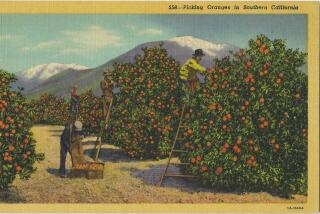Its name evokes visions of strawberry fields,...
- Share via
Its name evokes visions of strawberry fields, orange groves and rows of vegetables.
But despite the pastoral connotations, Bell Gardens is a residential community surrounded by a sea of light industry. Although the city’s mostly blue-collar residents have an average income that makes Bell Gardens the third-poorest suburb in the nation, the civic finances of the community once known as Billy Goat Acres are solid because of the revenue from legalized draw poker.
When the area was a vast orange grove in 1924, developer John Joseph Woodworth built himself a mansion with the intention of building others, envisioning a community that would rival Beverly Hills. But he was forced to scrap his ambitious efforts because of the Depression.
Instead of the wealthy, Woodworth’s community was settled by Midwesterners and Dust Bowl refugees who sought a better life and ended up living in cardboard piano boxes and tents on vacant lots.
During the 1940s and 1950s, the county did most of the zoning for the area and simply blanketed it with a zone that allowed everything from a factory to a home.
When the city incorporated in 1961, it inherited a planning mess, but set about trying to correct it. Residents wanted their city to contain neat geographical areas designated for businesses, homes and light manufacturing.
A decade later, in an attempt to clean up the hodgepodge, the city changed commercial zoning in predominantly residential areas to residential zoning. Officials gave commercial property owners and operators in the rezoned areas a 20-year grace period before the new regulations were enforced.
In the 1980s, the city launched an ambitious redevelopment program, tearing down more than 300 homes and leveling entire neighborhoods for park space and commercial development.
Tensions ran high until a grass-roots coalition of mostly Latino residents confronted an all-white City Council in 1991, accusing the members of trying to reduce Bell Gardens’ Latino population by legislating lower legal densities in neighborhoods.
Within months, the No-Rezoning Committee, drawing national media attention, ousted four of the five council members, bringing to power the first Latino council majority in Bell Gardens.
Tranquillity, however, did not follow the reformers’ hard-won victories. Allegations of illegal hiring practices dogged some council members, as well as allegations of voter fraud and of municipal jobs and scholarships being offered in return for votes. One council member was fined $1,500 by the Fair Political Practices Commission for casting a vote illegally and, eventually, Bell Gardens endured two more recall campaigns.
Regardless of the city’s political turmoil, the municipality remains stable with tax revenue from the large and popular Bicycle Club casino, although its proceeds have declined over the past few years. But, like the club’s patrons, Bell Gardens’ elected officials are betting that the club’s take will pick up.
* THE NAME GAME: In 1930, vegetable gardens that had been developed by Japanese entrepreneurs were subdivided and named after nearby Bell, which was founded by James G. Bell and his son, Alphonzo Edward Bell. The Bells also founded Santa Fe Springs and Bel-Air.
By the Numbers
CITY BUSINESS
Date incorporated: August 1, 1961
Area in square miles: 2
Number of city parks: 5
City employees: 120 fulltime; 55 part time
1996-97 operating budget: 16 million (capital & restricted funds excluded)
ETHNIC MAKEUP
Latino: 88%
White: 10%
Asian: 1%
Black / Other 1%
PEOPLE
Population: 42,355
Households: 9,300
Average hopusehold size: 5
Median age: 23
MONEY AND WORK
Median household income: $23,819
Median household income/LA County: $34,965
Median home value: $160,500
Employed workers (16 and older):17,476
Percentage of women employed: 49%
Percentage of men employed: 80%
Self-employed: 711
Carpoolers: 4,086
FAMILIES
Married couple families with children: 50%
Married couple families with no children: 11%
Other types of families: 27%
Nonfamily households: 12%
RETAIL STORES
Total stores: 212
Total employees: 1,475
Annual sales: $143 million
Source: Claritas Inc. retail figures are for 1995. All other figures are for 1990. Percentages have been rounded to the nearest whole number.
More to Read
Sign up for Essential California
The most important California stories and recommendations in your inbox every morning.
You may occasionally receive promotional content from the Los Angeles Times.










